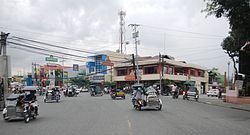Country Philippines Founded October 7, 1741 Time zone PST (UTC+8) Population 56,134 (2010) Local time Sunday 7:27 AM University Aldersgate College | District Lone district Barangays Area 139.8 km² Province Nueva Vizcaya Dialling code 78 | |
 | ||
Region Cagayan Valley (Region II) Weather 25°C, Wind W at 2 km/h, 85% Humidity | ||
Welcome to solano nueva vizcaya
Solano ([1]) is a first class urban municipality in the province of Nueva Vizcaya, Philippines. According to the 2015 census, it has a population of 59,517 people. Solano City is the main commercial and financial center of Nueva Vizcaya.
Contents
- Welcome to solano nueva vizcaya
- Map of Solano Nueva Vizcaya Philippines
- Barangays
- History
- Gobernadorcillos
- Culture and Tourism
- AM Stations
- FM Stations
- Schools
- Sister CityMunicipality
- References
Map of Solano, Nueva Vizcaya, Philippines
It has the most number of fast food restaurants in the province, including Jollibee, Greenwich Pizza, McDonald's, Chowking, Mang Inasal, Red Ribbon, Goldilocks and more.
It is also the financial hub of northern Vizcaya, with many major banks such as Metrobank, Banco de Oro, Bank of the Philippine Islands, Philippine National Bank, Landbank, Rizal Commercial Banking Corporation, China Bank as well as rural and regional banks maintaining their presence in the area. Solano has the most number of banks among the municipalities in the entire region with 25 banks.
According to the 2016 Cities and Municipalities Competitiveness Index conducted by the National Competitiveness Council, Solano took the 25th spot overall and ranked 30 among the first class and second class municipalities in the Philippines. This further solidified the status of Solano as the undisputed premier town of Cagayan Valley.
Solano, being the premier town in Nueva Vizcaya and the fastest-growing municipality in the region, is slated to become Cagayan Valley Region's 5th City after Tuguegarao, Santiago, Cauayan, and Ilagan.
Barangays
Solano is politically subdivided into 22 barangays.
History
In 1760, the original name of the town was Bintauan. Its pioneer settlers were the Gaddang tribe. The municipality was founded in 1767 by Father Alejandro Vidal, a Dominican priest who led a Spanish mission. In 1768, it was called "Lungabang", which means "cave" in the Gaddang dialect. The name was later changed to "Lumabang" by the Spaniards for convenience. In 1851, Governor General Antonio Urbiztondo declared Lumabang a barrio of Bayombong for not having sufficient inhabitants and revenue to maintain itself. Governor General Ramon Solano y Llanderal authorized the separation of Lumabang as barrio from Bayombong. In 1853, the first Ilocanos arrived brought by Don Diego Lumicao, former Gobernadorcillo. In 1889, it was renamed Solano, in honor of Governor General Ramon Solano y Llanderal. The town was planned by Father Juan Villaverde. The poblacion, as designed, consisted of 14 parallel wide streets, each having a width of 20 meters. The streets run from north to south and east to west forming 100 square blocks with an aggregate area of one hectare per block. Solano was the largest municipality in the province until two of its barangays, Caliat and Bintawan, were segregated to become the municipalities of Quezon and Villaverde respectively. The land area of Solano was correspondingly reduced to 13,980 hectares. In 1957, the barrios of Ibung and Bintawan were separated to form the town of Ibung, later renamed as Villaverde.
Gobernadorcillos
Under the Spanish regime, the "Gobernadorcillo" commonly called Municipal Mayor, Captain, Petty Governor was a native and elected annually. The election was made by the Cabezas de Barrangay - Heads of Barangay - which represented the survival of the earlier tribal organizations and were responsible for the tributes of their groups. The Heads were originally hereditary, but, in time, it became elective. The electors of the Gobernadorcillo were current or former heads of the Barrangay and after 3 years of service became eligible for the office of Petty Governor.
The following list shows the Gobernadorcillos, who had the honorary title "Don", during the Spanish regime from 1762-1898.
The following served as capitanes del pueblo:
The next three years, the town head was to be known gobernadorcillo, and the use of capitan del pueblo was stopped.
The following served as alcaldes de naturales:
On April 19, 1789, the alcalde mayor [of Cagayan] conveyed to the people the decree issued by the King of Spain ordering the restoration of the title gobernadorcillo.
By executive order of 1851, Governor-General Antonio Urbiztondo, Marquez de la Solana, declared Lumabang to become a barrio of Bayombong resulting in the office of gobernadorcillo (Bayombong) and teniente del barrio (of Solano/Lumabang).
It was during this time when a new province, Isabela, was created, carving a portion of Nueva Vizcaya and a part of Cagayan. The new province was named in honor of Queen Isabela of Spain. The Governor of Nueva Vizcaya was Julian del Valle. The alcalde mayor of Cagayan came here for the purpose of this reorganization.
General Ramon Solano y Llanderal authorized the separation of Lumabang as a barrio from Bayombong restoring the title of gobernadorcillo to Solano/Lumabang
There was a new order at this time to increase the term of a gobernadorcillo from one year to two years.
In 1890, the establishment of the office of the justice of the peace was inaugurated in all the towns, and the first to assume this office in Solano was Domingo Panganiban who was in turn succeed by Juan Sobrino, a Spaniard. who was succeeded by Sebastian Panganiban. who was then succeed by Domingo Panganiban who held this office til 1898.
It was during this time when the Royal Decree of the Central Government came stopping the use of the title gobernadorcillo and in its stead capitan municipal was to be used.
The government of Spain ended on September 14, 1898
Culture and Tourism
Tourism
Festival
AM Stations
FM Stations
Schools
University/College/Vocational School
High School
Elementary
Sister City/Municipality
Local
